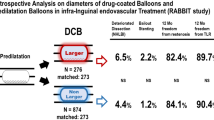Abstract
Background
A routine aspiration method in filter-protected carotid artery stenting (CAS) has been reported recently in which the proximal internal carotid artery (ICA) blood column was aspirated using an aspiration catheter after postdilatation regardless of flow state on digital subtraction angiography. We examined the debris particles captured by this method.
Methods
The routine aspiration method was used in 71 CAS procedures. In two procedures, captured debris particles were examined histologically. In the remaining 69 procedures, the size and number of debris particles were measured under a stereoscopic microscope, and then relationships between the amount of debris particles and clinical variables were evaluated using multivariate regression analysis.
Results
Histologically, the captured debris contained platelet-precipitating, thrombotic, lipid-rich fibrous and calcified material. The number of debris particles ≥1 mm was 19.6 ± 12.1 (mean ± SD) in 60 procedures with normal flow and 25.9 ± 17.2 (mean ± SD) in 9 procedures with slow/stop flow. Multivariate regression analysis demonstrated that extension of a proximal ICA angulation was an independent predictor of the amount of debris particles with a maximum diameter of either ≥1 mm or <1 mm but ≥0.5 mm (p < 0.05).
Conclusions
The captured debris appeared to originate from atheromatous plaques. If the routine aspiration method had not been used in the present series, the debris might have migrated into intracerebral arteries. Restriction of the extension of a proximal ICA angulation might reduce the amount of debris associated with CAS, especially when the proximal ICA angulation is pronounced.



Similar content being viewed by others
References
Angelini A, Reimers B, Della Barbera M, Saccà S, Pasquetto G, Cernetti C, Valente M, Pascotto P, Thiene G (2002) Cerebral protection during carotid artery stenting: collection and histopathologic analysis of embolized debris. Stroke 33:456–461
Casserly IP, Abou-Chebl A, Fathi RB, Lee DS, Saw J, Exaire JE, Kapadia SR, Bajzer CT, Yadav JS (2005) Slow-flow phenomenon during carotid artery intervention with embolic protection devices: predictors and clinical outcome. J Am Coll Cardiol 46:1466–1472
Hayashi K, Kitagawa N, Morikawa M, Hiu T, Morofuji Y, Suyama K, Nagata I (2009) Observation of the embolus protection filter for carotid artery stenting. Surg Neurol 72:532–537
Jansen O, Fiehler J, Hartmann M, Brückmann H (2009) Protection or nonprotection in carotid stent angioplasty: the influence of interventional techniques on outcome data from the SPACE Trial. Stroke 40:841–846
Katzen BT, Criado FJ, Ramee SR, Massop DW, Hopkins LN, Donohoe D, Cohen SA, Mauri L, Investigators CASES-PMS (2007) Carotid artery stenting with emboli protection surveillance study: thirty-day results of the CASES-PMS study. Catheter Cardiovasc Interv 70:316–323
Maleux G, Demaerel P, Verbeken E, Daenens K, Heye S, Van Sonhoven F, Nevelsteen A, Wilms G (2006) Cerebral ischemia after filter-protected carotid artery stenting is common and cannot be predicted by the presence of substantial amount of debris captured by the filter device. AJNR Am J Neuroradiol 27:1830–1833
Malik RK, Landis GS, Sundick S, Cayne N, Marin M, Faries PL (2010) Predicting embolic potential during carotid angioplasty and stenting: analysis of captured particulate debris, ultrasound characteristics, and prior carotid endarterectomy. J Vasc Surg 51:317–312
North American Symptomatic Carotid Endarterectomy Trial Collaborators (1991) Beneficial effect of carotid endarterectomy in symptomatic patients with high-grade carotid stenosis. N Engl J Med 325:445–453
Schofer J, Arendt M, Tübler T, Sandstede J, Schlüter M (2008) Late cerebral embolization after emboli-protected carotid artery stenting assessed by sequential diffusion-weighted magnetic resonance imaging. J Am Coll Cardiol Intv 1:571–577
Sorimachi T, Nishino K, Morita K, Sasaki O, Koike T, Ito Y, Fujii Y (2010) Obstruction of pores in distal protection filters and angiographically-documented flow impairment during carotid artery stenting. J Endovasc Ther 17:661–670
Sorimachi T, Nishino K, Morita K, Takeuchi S, Ito Y, Fujii Y (2011) Blood flow changes caused by distal filter protection and catheter aspiration in the internal carotid artery during carotid stenting: evaluation using carotid Doppler sonography. AJNR Am J Neuroradiol 38:288–293
Sorimachi T, Nishino K, Shimbo J, Morita K, Ito Y, Fujii Y (2010) Routine use of debris aspiration before retrieval of distal filter protection devices in carotid arterial stenting: analysis of captured debris and evaluation of clinical results. Neurosurgery 67:1260–1267
Tsutsumi M, Kodama T, Aikawa H, Onizuka M, Iko M, Nii K, Hamaguchi S, Etou H, Sakamoto K, Inoue R, Nakau H, Kazekawa K (2010) Fragmentation of calcified plaque after carotid artery stenting in heavily calcified circumferential stenosis. Neuroradiology 52:831–836
Conflicts of interest
None.
Author information
Authors and Affiliations
Corresponding author
Rights and permissions
About this article
Cite this article
Sorimachi, T., Kakita, A., Morita, K. et al. Routine aspiration method during filter-protected carotid stenting: histological evaluation of captured debris and predictors for debris amount. Acta Neurochir 153, 2159–2167 (2011). https://doi.org/10.1007/s00701-011-1093-3
Received:
Accepted:
Published:
Issue Date:
DOI: https://doi.org/10.1007/s00701-011-1093-3




